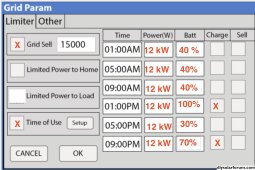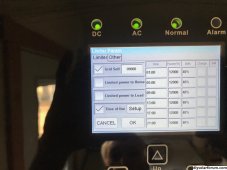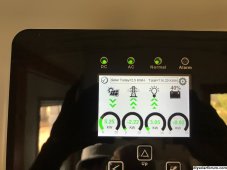As a newbie with solar panel systems, I'm uncertain about time of use settings on my Sol-Ark 15K attached to a Fortress max eVault 18 kWh battery.
The objectives I have are as follows:
1) Have solar charge the battery during peak production hours. 1pm in this case.
2) Don't discharge the battery below 30%
3) The primary time for battery usage with be from about 5 pm until 9 pm. Estimating need for 12Kwh in that time period.
4) I'd like to have the battery be charged enough so that it will not fall below 40% overnight, in the event of an overnight grid outage. Am thinking that going from 70% to 40% gives me plenty of battery power (about 5.4 kWh) for the period between 9 pm and 9 am. By 9 am in the morning, I'll either have enough solar to recharge, or be able to have plenty of daylight time to attach my generator to recharge the battery.
I'm thinking that the following time of use settings will accomplish these goals, although I am certain that I'm not certain! I recognize that there are likely many other things that should probably be considered.
 And a few general questions about the settings:
And a few general questions about the settings:
1) Should the Power column use a constant value, or should that be varied, as I have seen in some setups? In this case, I used 12 kW as a constant, which is 2/3 of the full battery capacity. I have no idea if that's "correct" or not.
2) Even though I've checked the "Charge" box at 1 pm and 9 pm, am thinking that if I have plenty of solar at 1 pm, it will not require, and won't take, any charge from the grid. True? I am expecting the need to charge from the grid at 9 pm to get back up the 70% level.
3) Am I correct in thinking that charging the battery from the grid at 9pm from 30% to 70% should only require about 7.2 kWh of power from the grid? (If that's so, it sure seems like a cheap way to charge the battery).
Will appreciate any input that will help me learn more about the time of use settings.
Thanks in advance!
The objectives I have are as follows:
1) Have solar charge the battery during peak production hours. 1pm in this case.
2) Don't discharge the battery below 30%
3) The primary time for battery usage with be from about 5 pm until 9 pm. Estimating need for 12Kwh in that time period.
4) I'd like to have the battery be charged enough so that it will not fall below 40% overnight, in the event of an overnight grid outage. Am thinking that going from 70% to 40% gives me plenty of battery power (about 5.4 kWh) for the period between 9 pm and 9 am. By 9 am in the morning, I'll either have enough solar to recharge, or be able to have plenty of daylight time to attach my generator to recharge the battery.
I'm thinking that the following time of use settings will accomplish these goals, although I am certain that I'm not certain! I recognize that there are likely many other things that should probably be considered.
 And a few general questions about the settings:
And a few general questions about the settings:1) Should the Power column use a constant value, or should that be varied, as I have seen in some setups? In this case, I used 12 kW as a constant, which is 2/3 of the full battery capacity. I have no idea if that's "correct" or not.
2) Even though I've checked the "Charge" box at 1 pm and 9 pm, am thinking that if I have plenty of solar at 1 pm, it will not require, and won't take, any charge from the grid. True? I am expecting the need to charge from the grid at 9 pm to get back up the 70% level.
3) Am I correct in thinking that charging the battery from the grid at 9pm from 30% to 70% should only require about 7.2 kWh of power from the grid? (If that's so, it sure seems like a cheap way to charge the battery).
Will appreciate any input that will help me learn more about the time of use settings.
Thanks in advance!





